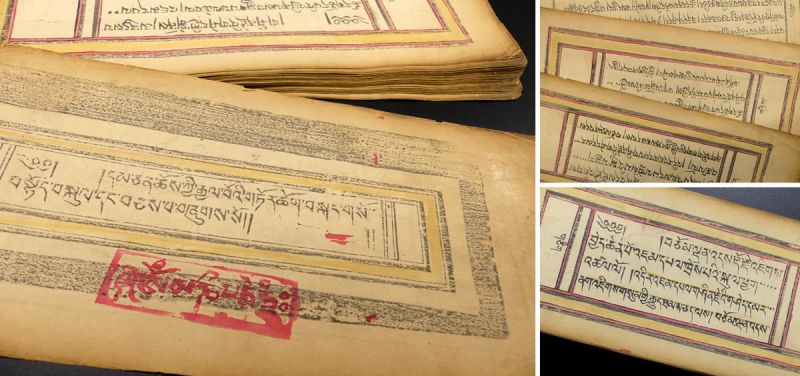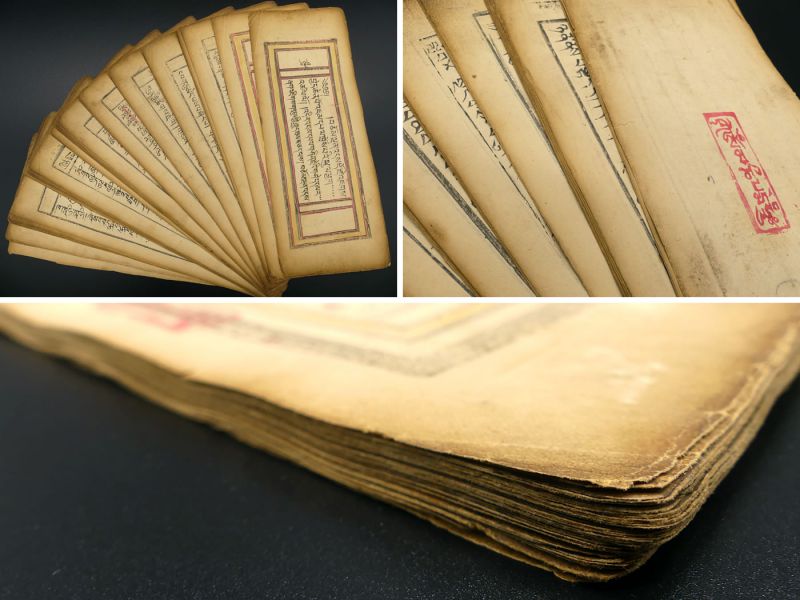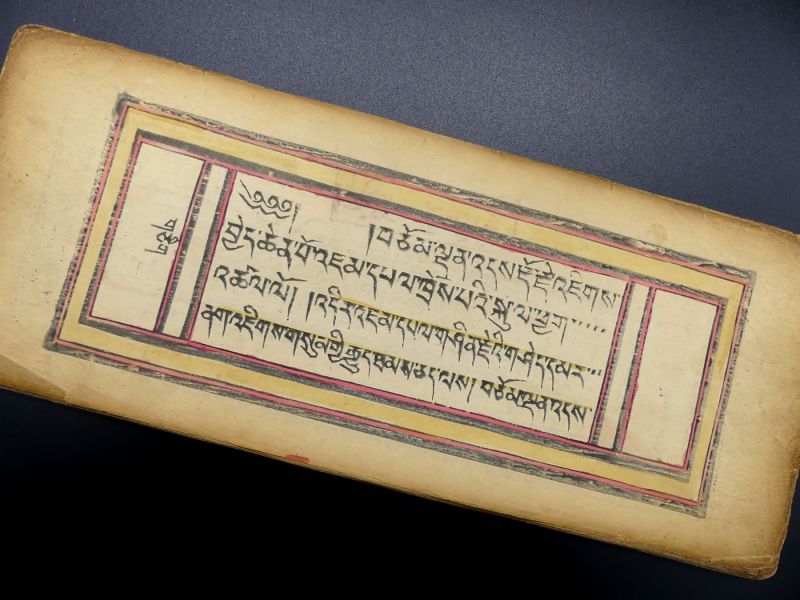Antikes Sutra mit Vajrabhairava Ritual-Text um 1900
2541
Antikes Sutra (sÅ«tra - Gebetbuch) mit Vajrabhairava (Yamantaka) Ritual-Text; um 1900; 46 doppelseitig beschriftete Mantra-Blätter; rot gestempelt; im Buddhismus ist das Rezitieren von Mantras ein wichtiges Instrument auf dem Weg zur Erleuchtung und zur Entwicklung des Geistes; Sutras sind kurze Buddhistische Texte oder Verse und enthalten die Lehre Buddhas (Dharma, Sanskrit: धरà¥à¤®à¤¸à¥à¤¤à¥à¤° dharmasÅ«tra)
die Vajrabhairava ist eine wichtige Meditations-Gottheit mit einem Büffelkopf und dem Kopf des Manjushri; die Texte beinhalten eine Tantra-Praxis um Hindernisse zu überwinden; diese Praxis hat ihren Ursprung im 14. Jahrhundert und „Yamantaka“ ist eine der bedeutendsten Gottheiten der Gelugpas (dge lugs - à½à½à½ºà¼à½£à½´à½à½¦à¼à½à¼ à½à½à½ à¼à½£à¾¡à½à¼à½£à½´à½à½¦à¼); aus dem Inhalt: das „pan chen bla ma (auch Penchen Lama)“, eine bedeutende Reinkarnationslinie des Gelug-Ordens im tibetischen Buddhismus; diese Praxis hat sich in der Gelug-Tradition sehr stark durchgesetzt und wurde nicht nur unter den Tibetern populär, sondern hat sich auch in den Gebieten der Mongolei und Mandschurei verbreitet;
auf Vollständigkeit nicht überprüft; an den Rändern vergilbt und teilweise kleine Risse; dem Alter entsprechende Gebrauchsspuren (siehe Fotos); Maße: ca. 9 x 22 cm; besichtigt vom Institut für Südasien-, Tibet- und Buddhismuskunde | Universität Wien
Antique sutra (sÅ«tra - prayer book) with Vajrabhairava (Yamantaka) ritual text; c. 1900; 46 double-sided mantra leaves; stamped red; in Buddhism, the recitation of mantras is an important tool on the path to enlightenment and the development of the mind; sutras are short Buddhist texts or verses and contain the Buddha's teachings (Dharma, Sanskrit: धरà¥à¤®à¤¸à¥à¤¤à¥à¤° dharmasÅ«tra).
the Vajrabhairava is an important meditation deity with a buffalo head and the head of Manjushri; the texts include a tantra practice to overcome obstacles; this practice originated in the 14th century. Century and "Yamantaka" is one of the most important deities of the Gelugpas (dge lugs - à½à½à½ºà¼à½£à½´à½à½¦à¼à½à¼ à½à½à½ à¼à½£à¾¡à½à¼à½£à½´à½à½¦à¼); from the content: the "pan chen bla ma (also Penchen Lama)", an important reincarnation lineage of the Gelug order in Tibetan Buddhism; this practice has become very popular in the Gelug tradition and has not only become popular among Tibetans, but has also spread to areas of Mongolia and Manchuria;
not checked for completeness; yellowed at the edges and partly small tears; traces of use corresponding to its age (see photos); dimensions: approx. 9 x 22 cm; inspected by the Institute for South Asian, Tibetan and Buddhist Studies | University of Vienna.


